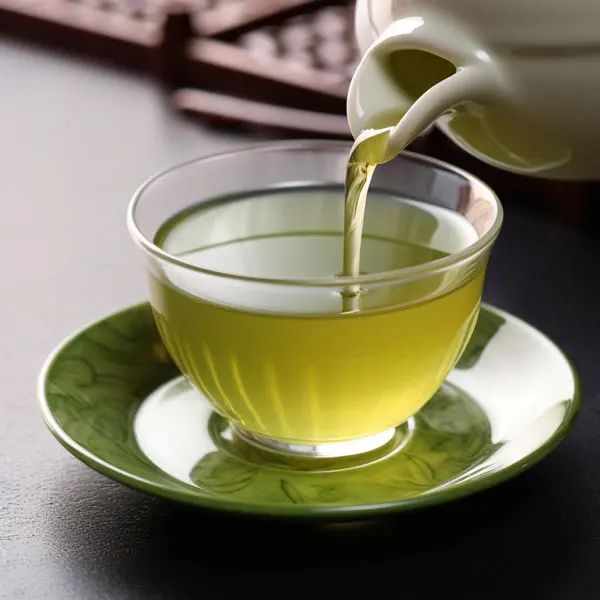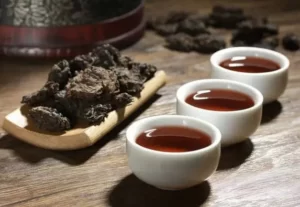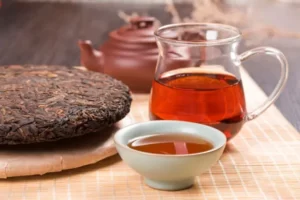Introduction
Yixing Zisha teapots are expensive because its good clay is very scarce. If stored improperly it will grow moldy spots and produce odors, which can be very distressing if you cannot continue to use it. This guide will allow you to avoid many of the pitfalls of storing a Zisha teapot.
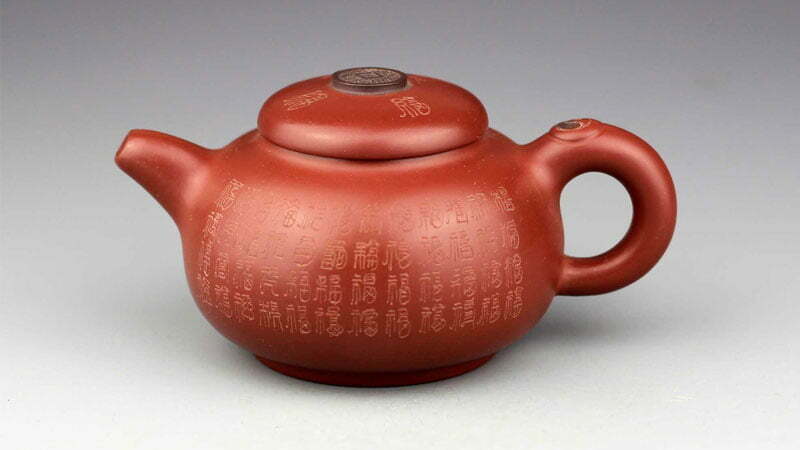
Ever wondered why your zisha teapot develops mold spots? Or maybe you’re unsure how to revive a teapot once it’s been afflicted by this issue? This guide, backed by ten years of experience, is dedicated to equipping you with all the knowledge needed to store and maintain your zisha teapots.
Understanding the Cause of Mold Spots
The primary reason for mold growth in your teapot is improper storage after cleaning. If the lid is placed back on the teapot before it’s thoroughly dry, residual moisture trapped inside creates a favorable environment for mold. Furthermore, high ambient humidity, especially during a rainy season, combined with inadequate air circulation, can also lead to mold formation if the teapot is not stored correctly.
Rescuing Your Zisha Teapot from Mold Spots
If mold spots appear on your teapot, don’t despair. The teapot can be revived by first pouring boiling water inside until the teapot is thoroughly heated. Once heated, discard the hot water and replace it with cool, previously boiled water. Repeat this process several times to remove both the mold spots and the associated smell. The principle behind this technique lies in the unique breathable and contractile properties of Yixing clay. It reacts to temperature changes much like human skin pores do—contracting and expanding.

Why Does Your Unused Yixing Teapot Have an Odd Smell?
Often, some tea enthusiasts receive their teapot, leave it in the box unopened, and let it remain tightly sealed inside. It’s important to know that the packaging boxes, which are generally glued together, can give off an odor that the Yixing clay teapot can absorb. This is why it’s recommended to rinse your Yixing teapot with boiling water before the first use – to get rid of this absorbed smell.
No matter whether you plan to use your zisha teapot immediately or not, once you receive it, I suggest you open the packaging box and take out the teapot for safety reasons. First, it allows you to inspect the teapot for any damage that may have occurred during shipping, providing you with the opportunity to ask for a replacement or compensation from the seller promptly. Secondly, it prevents the teapot from absorbing any odd odors from the packaging box.
Sometimes, when you finally unbox a teapot that has remained in its packaging, even though it’s a zisha teapot master handcrafted piece that cost a pretty penny, you might notice an off-putting smell. Don’t be quick to blame the seller; it might just be that the teapot has absorbed odors from being confined within its packaging for too long.
Maintaining Multiple Yixing Zisha Teapots
As an avid tea enthusiast, it’s likely that you own more than one or two zisha teapots. However, using multiple pots simultaneously risks them bumping into each other and causing damage. To prevent this, it’s crucial to allow each pot to “rest” after use, and each “resting” teapot requires its specific care routine.
Some may wonder, “Is it necessary to go through all this trouble just to store a teapot?” The answer is a resounding “yes.” At the very least, you must ensure that your teapot is clean and free from residual tea leaves. Trust me, the extra effort only brings benefits.
The Wrong Way to Store Your Zisha Teapots
A common, yet misguided practice among tea enthusiasts is to simply rinse their teapots and place them back into their original silk-lined boxes. This is not advisable. Storing your Yixing teapot in a silk box restricts airflow, encouraging the growth of mold on tea stains within the pot, which could produce an unpleasant odor and potential health concerns.
Proper Storage Practices for Your Zisha Teapot
If you plan on storing your Yixing teapot for an extended period, follow these four steps:
1. Clean Your Teapot
It’s best to clean your teapot with purified water instead of tap water. Rinse both the inside and outside with boiling purified water, then invert it to dry. The high temperature of the boiling water ensures the teapot dries quickly.
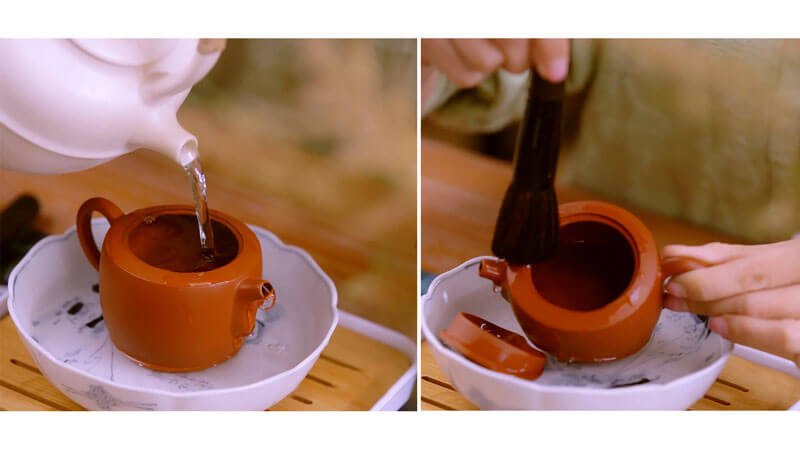
2. Air-Dry Your Teapot
After cleaning, allow your teapot to air dry completely. Place it with the lid off in a well-ventilated indoor area, away from direct sunlight, for 7-8 days. To check if your teapot is thoroughly dry, place a tissue inside, cover with the lid, and check the next day. If the tissue is damp, continue the drying process. Any residual moisture can lead to mold growth.

3. Storage Environment
Store your teapots in a well-ventilated area away from direct sunlight, extreme heat, and kitchen fumes. If possible, dedicate a shelf for your teapots.
Here’s a little tidbit: a friend of mine bought a Yixing clay teapot and only used it two or three times before putting it aside. He lives in a city where the weather is hot, and the teapot was often left in a sunny spot. Then one day, he suddenly thought of this pot; when he poured water on it, the spout broke off directly. So why did this happen? Although the storage environment is not as hot as in the kiln, because it’s often exposed to the sun, the pot became too dry. When 100°C boiling water was poured in, it cracked easily.

4. Periodic Check-Ups
If you’re storing your teapot for an extended period, place dry tea leaves (of the type usually brewed in that teapot) inside. Regularly check the tea leaves for any signs of moisture, and if found, remove the leaves, dry the teapot thoroughly again, and replace the leaves. This method absorbs residual moisture, preventing mold growth.
Your Yixing zisha teapot is a treasured possession. Just as you take care of yourself, you need to care for your teapot. A well-maintained teapot stays clean and lasts longer. Conversely, neglect can lead to a dirty teapot that develops various issues over time.
Remember, even if you’re not using a teapot for a while, it still requires care. As a true tea lover, learning proper teapot maintenance is key to ensuring your teapot’s longevity. With these practices in place, your teapot is ready for use at a moment’s notice – just rinse with hot water once or twice!
Proper storage of your Yixing teapot, even when temporarily not in use, is not just a suggestion but a necessity. Understanding and implementing the right care methods not only ensure the lifespan of your teapot but also enhance your tea-drinking experience.
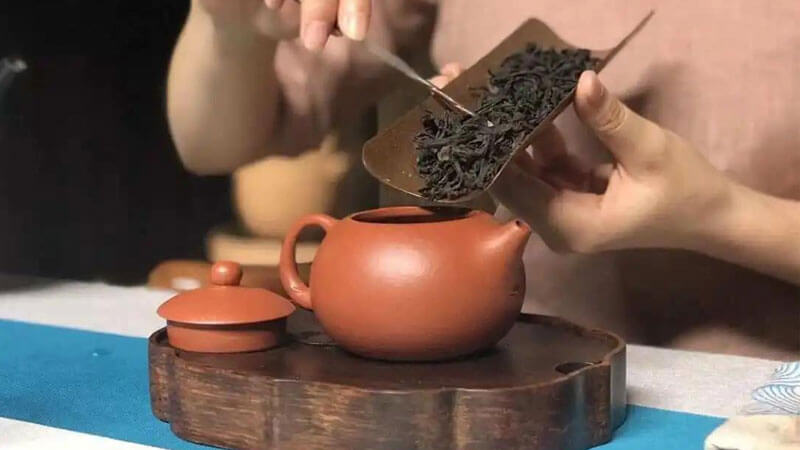
FAQ
Question 1: Can I use soap or detergent to clean my Yixing teapot?
Answer 1: It’s generally not recommended to use soap or detergents to clean a Yixing teapot. These can penetrate the porous clay and affect the flavor of your tea. Stick to rinsing with hot water to clean your teapot.
Question 2: Can I brew different types of tea in my Yixing teapot?
Answer 2: Yixing teapots are known to absorb the flavors of the teas brewed in them, which is why it’s generally recommended to dedicate each teapot to a specific type of tea. Mixing different types of tea in the same pot can result in an undesirable combination of flavors.
Question 3: How can I remove tea stains from my Yixing teapot?
Answer 3: To remove tea stains, it’s recommended to use a soft sponge and hot water. Abrasive cleaners or tools could damage the teapot’s surface. For stubborn stains, soaking the teapot in hot water for a few hours can help loosen them.
